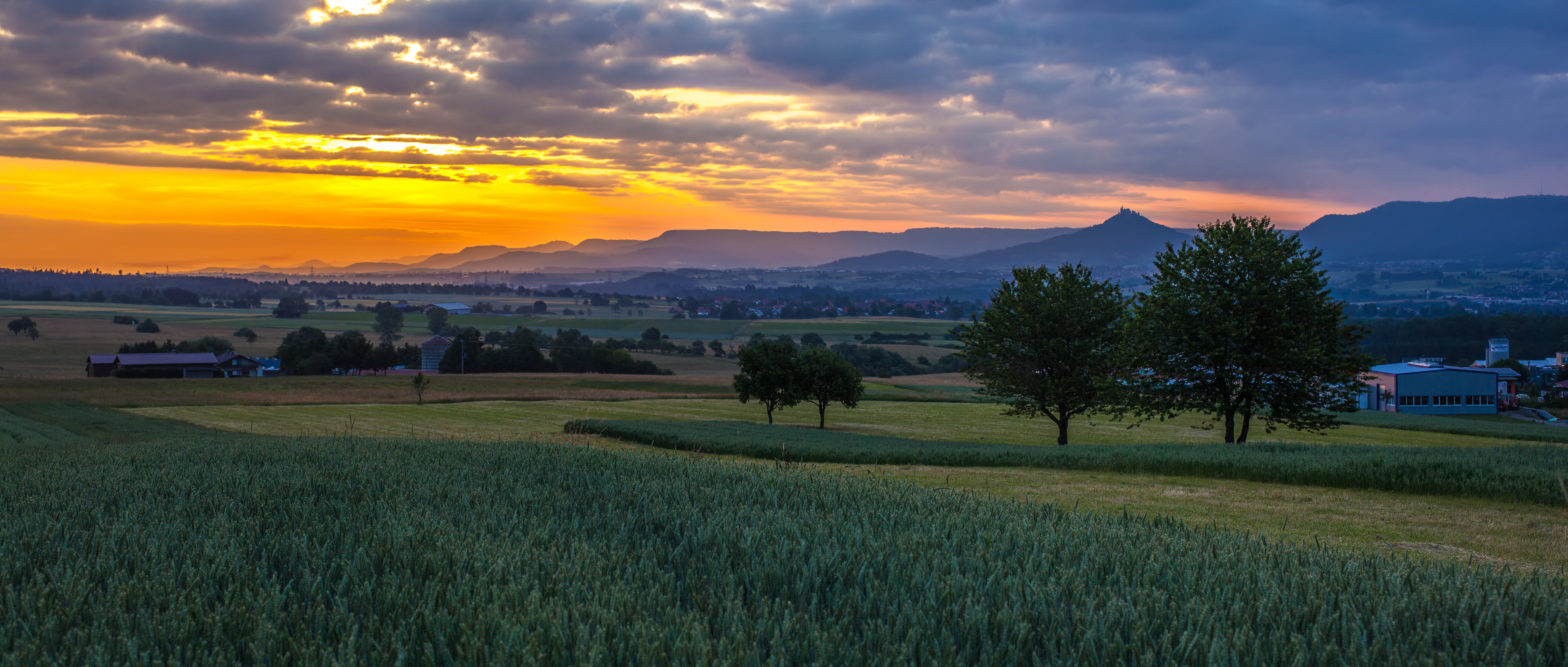|
Römerstein (Schwäbische Alb)
Römerstein is a municipality in Baden-Württemberg, Germany; three formerly independent villages (Böhringen, Donnstetten, Zainingen) and two hamlets (Strohweiler and Aglishardt) were merged in 1975. Administration seat is Böhringen. The community is located on the Swabian Alb, in the northeastern corner of the district of Reutlingen. The community is named after the Römerstein, the highest hill of the region at 875 m. Geography The municipality is located about 22 kilometers east of Reutlingen on the plateau of the Swabian Alb at an altitude of 803 m above sea level. NN (Rathaus Donnstetten). Römerstein reaches an elevation of 874 m above sea level at its highest point. The municipality is bordered by Lenningen (Esslingen district) Wiesensteig (Göppingen District), Westerheim, Laichingen (both Alb-Donau-Kreis), Gutsbezirk Münsingen, Bad Urach and grave Stetten (all district Reutlingen). Municipality arrangement The community consists of the previously independent munici ... [...More Info...] [...Related Items...] OR: [Wikipedia] [Google] [Baidu] |
Ortsteil
A village is a human settlement or Residential community, community, larger than a hamlet (place), hamlet but smaller than a town with a population typically ranging from a few hundred to a few thousand. Although villages are often located in rural areas, the term urban village is also applied to certain urban neighborhoods. Villages are normally permanent, with fixed dwellings; however, transient villages can occur. Further, the dwellings of a village are fairly close to one another, not scattered broadly over the landscape, as a dispersed settlement. In the past, villages were a usual form of community for societies that practice subsistence agriculture and also for some non-agricultural societies. In Great Britain, a hamlet earned the right to be called a village when it built a Church (building), church. [...More Info...] [...Related Items...] OR: [Wikipedia] [Google] [Baidu] |
Baden-Württemberg
Baden-Württemberg ( ; ), commonly shortened to BW or BaWü, is a states of Germany, German state () in Southwest Germany, east of the Rhine, which forms the southern part of Germany's western border with France. With more than 11.07 million inhabitants across a total area of nearly , it is the third-largest German state by both List of German states by area, area (behind Bavaria and Lower Saxony) and List of German states by population, population (behind North Rhine-Westphalia and Bavaria). The List of cities in Baden-Württemberg by population, largest city in Baden-Württemberg is the state capital of Stuttgart, followed by Mannheim and Karlsruhe. Other major cities are Freiburg im Breisgau, Heidelberg, Heilbronn, Konstanz, Pforzheim, Reutlingen, Tübingen, and Ulm. Modern Baden-Württemberg includes the historical territories of Baden, Prussian Province of Hohenzollern, Hohenzollern, and Württemberg. Baden-Württemberg became a state of West Germany in April 1952 through ... [...More Info...] [...Related Items...] OR: [Wikipedia] [Google] [Baidu] |
Germany
Germany, officially the Federal Republic of Germany, is a country in Central Europe. It lies between the Baltic Sea and the North Sea to the north and the Alps to the south. Its sixteen States of Germany, constituent states have a total population of over 84 million in an area of , making it the most populous member state of the European Union. It borders Denmark to the north, Poland and the Czech Republic to the east, Austria and Switzerland to the south, and France, Luxembourg, Belgium, and the Netherlands to the west. The Capital of Germany, nation's capital and List of cities in Germany by population, most populous city is Berlin and its main financial centre is Frankfurt; the largest urban area is the Ruhr. Settlement in the territory of modern Germany began in the Lower Paleolithic, with various tribes inhabiting it from the Neolithic onward, chiefly the Celts. Various Germanic peoples, Germanic tribes have inhabited the northern parts of modern Germany since classical ... [...More Info...] [...Related Items...] OR: [Wikipedia] [Google] [Baidu] |
Swabian Alb
The Swabian Jura ( , more rarely ), sometimes also named Swabian Alps in English, is a mountain range in Baden-Württemberg, Germany, extending from southwest to northeast and in width. It is named after the region of Swabia. It is part of the Table Jura (). The Swabian Jura occupies the region bounded by the Danube in the southeast and the upper Neckar in the northwest. In the southwest it rises to the higher mountains of the Black Forest. The highest mountain in the region is the Lemberg (). The area's profile resembles a high plateau, which slowly falls away to the southeast. The northwestern edge is a steep escarpment (called the Albtrauf or Albanstieg, rising up , covered with forests), while the top is flat or gently rolling. In economic and cultural terms, the Swabian Jura includes regions just around the mountain range. It is a popular recreation area. The whole ''Schwäbische Alb'' area is a UNESCO global geopark covering 6,688 km2 (2582 sq mi.); it was designate ... [...More Info...] [...Related Items...] OR: [Wikipedia] [Google] [Baidu] |
Reutlingen (district)
Reutlingen, nicknamed "The Gate to the Swabian Alb" (), is a Districts of Germany, ''Landkreis'' (district) in the middle of Baden-Württemberg, Germany. The former free imperial city (until 1802) reached the limit of 100,000 residents in 1989. It is the ninth-largest city in Baden-Württemberg. Reutlingen district's neighbouring districts are (from north clockwise) Esslingen (district), Esslingen, Göppingen (district), Göppingen, Alb-Donau (district), Alb-Donau, Biberach (district), Biberach, Sigmaringen (district), Sigmaringen, Zollernalbkreis, Tübingen (district), Tübingen and Böblingen (district), Böblingen. History The district dates back to the ''Oberamt Reutlingen'', which was created in 1803 when the previously free imperial city Reutlingen became part of Württemberg. In 1934, it was converted into the district, in 1938 the district Urach was dissolved and split between the districts Reutlingen and Münsingen. In 1973 the district Münsingen was dissolved, and most p ... [...More Info...] [...Related Items...] OR: [Wikipedia] [Google] [Baidu] |
Reutlingen
Reutlingen (; ) is a city in Baden-Württemberg, Germany. It is the capital of the eponymous Reutlingen (district), district of Reutlingen. As of June 2018, it had an estimated population of 116,456. Reutlingen has a Reutlingen University, university of applied sciences, which was founded in 1855, originally as a weavers' school. Today, Reutlingen is a home to an established textile industry and also houses machinery, leather goods and steel manufacturing facilities. It has the narrowest street in the world, Spreuerhofstraße (width 31 cm). Geography Reutlingen is located about south of the State capital of Baden-Württemberg, Stuttgart. It lies in the Southwest corner of Germany, right next to the Swabian Jura, and that is why it is often called ''The gateway to the Swabian Alps, Swabian Jura'' (). The Echaz river, a tributary of the Neckar, flows through the city centre. Along with the old college town, university town of Tübingen (about to the west), Reutlingen is ... [...More Info...] [...Related Items...] OR: [Wikipedia] [Google] [Baidu] |
Toponym
Toponymy, toponymics, or toponomastics is the study of ''wikt:toponym, toponyms'' (proper names of places, also known as place names and geographic names), including their origins, meanings, usage, and types. ''Toponym'' is the general term for a proper name of any geographical feature, and full scope of the term also includes proper names of all cosmographical features. In a more specific sense, the term ''toponymy'' refers to an inventory of toponyms, while the discipline researching such names is referred to as ''toponymics'' or ''toponomastics''. Toponymy is a branch of onomastics, the study of proper names of all kinds. A person who studies toponymy is called ''toponymist''. Etymology The term ''toponymy'' comes from / , 'place', and / , 'name'. The ''Oxford English Dictionary'' records ''toponymy'' (meaning "place name") first appearing in English in 1876 in the context of geographical studies. Since then, ''toponym'' has come to replace the term ''place-name'' in profe ... [...More Info...] [...Related Items...] OR: [Wikipedia] [Google] [Baidu] |
German Red Cross
The German Red Cross (GRC) ( ; DRK) is the national Red Cross Society in Germany. During the Nazi era, the German Red Cross was under the control of the Nazi Party and played a role in supporting the regime's policies, including the exclusion of Jewish members and collaboration with the war effort. With 4 million members, it is the third largest Red Cross society in the world. The German Red Cross offers a wide range of services within and outside Germany. GRC provides 52 hospitals, elderly care (over 500 nursing homes and a mobile nursing care network covering the entire country), care for children and youth (i.e., 1,300 kindergartens, a full range of social services for children). GRC also provides 75% of the blood supply and 60% of the emergency medical services in Germany, as well as first aid training. GRC headquarters provides international humanitarian aid ( disaster management and development assistance) to over 50 countries across the world. Voluntary societies o ... [...More Info...] [...Related Items...] OR: [Wikipedia] [Google] [Baidu] |
Swabian Albverein
Swabian or Schwabian, or ''variation'', may refer to: * the German region of Swabia (German: "''Schwaben''") * Swabian German, a dialect spoken in Baden-Württemberg in south-west Germany and adjoining areas (German:"''Schwäbisch''") * Danube Swabian people of German origin from the German state of Baden-Württemberg living in Hungary, Croatia, Romania, Serbia * Swabians, an ethnic group of Germany See also * Swabia (other) * Swabian Alb, a mountainous region within Swabia * Duke of Swabia * Swabian Circle * Swabian League * Swabian War The Swabian War of 1499 ( (spelling depending on dialect), called or ("Swiss War") in Germany and ("War of the Engadin" in Austria) was the last major armed conflict between the Old Swiss Confederacy and the House of Habsburg. What had begun ... * * * * {{disambig Language and nationality disambiguation pages ... [...More Info...] [...Related Items...] OR: [Wikipedia] [Google] [Baidu] |
Saint Christopher
Saint Christopher (, , ; ) is venerated by several Christian denominations. According to these traditions, he was a martyr killed in the reign of the 3rd-century Roman Empire, Roman emperor Decius (), or alternatively under the emperor Maximinus Daia (). Churches and monasteries were named after him by the 7th century. There is no evidence for the historicity of the saint.Britannica, The Editors of Encyclopaedia. "Saint Christopher" Encyclopedia Britannica, 25 July 2024, https://www.britannica.com/biography/Saint-Christopher. Accessed 25 October 2024. The most famous legend connected to the saint recounts that after converting to Christianity, he devoted his life to carrying travelers across a river. One day he carried an unknown young boy across a river after which the boy reve ... [...More Info...] [...Related Items...] OR: [Wikipedia] [Google] [Baidu] |
Pietism
Pietism (), also known as Pietistic Lutheranism, is a movement within Lutheranism that combines its emphasis on biblical doctrine with an emphasis on individual piety and living a holy Christianity, Christian life. Although the movement is aligned with Lutheranism, it has had a tremendous impact on Protestantism worldwide, particularly in North America and Europe. Pietism originated in modern Germany in the late 17th century with the work of Philipp Spener, a Lutheran theologian whose emphasis on personal transformation through spiritual rebirth and renewal, individual devotion, and piety laid the foundations for the movement. Although Spener did not directly advocate the Quietism (Christian contemplation), quietistic, legalistic, and semi-separatist practices of Pietism, they were more or less involved in the positions he assumed or the practices which he encouraged. Pietism spread from Germany to Switzerland, the rest of German-speaking Europe, and to Scandinavia and the Balt ... [...More Info...] [...Related Items...] OR: [Wikipedia] [Google] [Baidu] |





